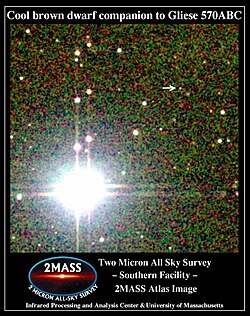Gliese 570
 The ternary star system Gliese 570. The T-type methane brown dwarf Gliese 570D is indicated with an arrow. Credit: 2MASS |
|
| Observation data Epoch J2000.0 Equinox J2000.0 |
|
|---|---|
| Constellation | Libra |
| Right ascension | 14h 57m 28.00144s |
| Declination | −21° 24′ 55.7131″ |
| Apparent magnitude (V) | 5.64 / ? / 9.90 |
| Characteristics | |
| Spectral type | K4V / M1V / M3V / T7V |
| U−B color index | 1.06 /1.22 |
| B−V color index | 1.11 / 1.51 |
| Variable type | None |
| Astrometry | |
| Radial velocity (Rv) | +27.9 km/s |
| Proper motion (μ) |
RA: 1037.06 mas/yr Dec.: -1725.87 mas/yr |
| Parallax (π) | 171.22 ± 0.94mas |
| Distance | 19.0 ± 0.1 ly (5.84 ± 0.03 pc) |
| Absolute magnitude (MV) | 6.79 / ? / 11.05 |
| Details | |
| Mass | 0.802 ± 0.040 / 0.55 / 0.35 / 0.05 M☉ |
| Radius | 0.739 ± 0.019 / 0.65 R☉ |
| Luminosity (bolometric) | 0.22 / 0.04 / ? / 3•10−6 L☉ |
| Luminosity (visual, LV) | 0.16 / 0.02 / 0.003 / ? L☉ |
| Temperature | 4597 ± 101 / 2700 K |
| Metallicity | |
| Rotation | 48.3 days |
| Rotational velocity (v sin i) | 1.50 km/s |
| Other designations | |
| Database references | |
| SIMBAD | The system |
| ABC | |
| A | |
| BC | |
| D | |
| Exoplanet Archive | data |
| ARICNS | data |
Gliese 570, also known as 33 G. Librae, is a ternary star system approximately 19 light-years away. The primary star is an orange dwarf star (much dimmer and smaller than the Sun). The other secondary stars are themselves a binary system, two red dwarfs that orbit the primary star. A brown dwarf has been confirmed to be orbiting in the system. In 1998, an extrasolar planet was thought to orbit the primary star, but it was discounted in 2000.
In the night sky, the Gliese 570 system lies in the southwestern part of Libra. The system is southwest of Alpha Librae and northwest of Sigma Librae. In the early 1990s, the European Hipparcos mission measured the parallax of components B and C, suggesting that the system was at a distance of 24.4 light-years from the Sun. This, however, was a relatively large error as Earth-based parallax and orbit observations suggest that the two stars are actually part of a system with Gliese 570 A, and must actually lie at the same distance.
The primary star of the system (component A) is an orange dwarf star that may just have over three fourths the mass of the Sun, about 77 percent of its radius, and only 15.6 percent of its visual luminosity. It has a separation of 190 astronomical units from the binary components B and C, moving in an eccentric orbit that takes at least 2130 years to complete. Gliese 570 A is spectral type K4V and emits X-rays.
...
Wikipedia

![{\begin{smallmatrix}\left[{\frac {Fe}{H}}\right]\ =\ 0.06\end{smallmatrix}}](https://wikimedia.org/api/rest_v1/media/math/render/svg/1140bc04e494a2dfd4b5af2027e7b9976f913fe3)